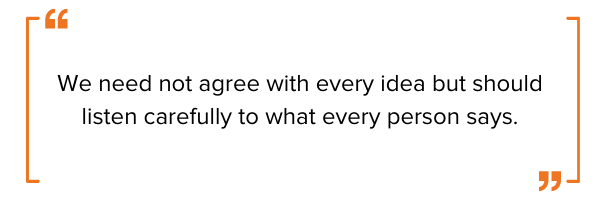I am fresh off facilitating a Fierce Team Conversations training for a client, and every time I do, I am reminded of how powerful it is. It’s invigorating for me to witness the collaboration, the ideas sparked, and even the empathy and deeper understanding between team members after we’ve completed the Beach Ball conversation. However, teams often lack the framework or even the context to seek out other perspectives to make better decisions. That’s where we come in!
A collaborative conversation engages employees, fosters trust, and helps us make the best possible decisions through seeking diversity of ideas. Let’s be honest, even if you come up with a great idea, it pays to seek out input and perspective from others to get fresh and contrasting perspectives.
Consult Your Team for Better Decision-Making
We need the perspective of others to see things clearly and thus make the best decisions. Hearing different perspectives, including those that might differ from our own, will help challenge our thinking, and help identify biases and risks in our decisions. It will also help us make a decision that everyone feels connected to.
When we operate in a silo, we’re often too close to the decision to spot its flaws. Highly effective leaders are confident in admitting they don’t have all the answers. They welcome and value the perspectives of others! They actively seek a mix of team members or stakeholders who offer perspectives or ideas they may not be aware of. Some with subject matter expertise, some with deep experience, but also the recent hires and client/customer facing team members with fresh approaches and ideas.
Many leaders shy away from consulting with their team before making decisions. They are wary of adding complexities, clashing opinions, and they overrate their own abilities and experience. Many leaders pretend to want input but do nothing with it, others ignore it all together (when Hewlett-Packard ignored their employee Steve Wozniak’s input, he quit, teamed up with a man named Steve Jobs, and founded a little company called ‘Apple.’)
How the issue or problem is framed affects how the team members think of solutions. For example, “Should we change our customer feedback survey?” is a narrow question that limits options. Perhaps “How do we better understand what our customers want?” might help achieve a better result.
We encourage critical thinking by asking probing questions. “Can you tell me a little more about why you think that?” “What else?” We keep the conversation open and honest to prevent brainstorming from turning into consensual groupthink.
We need not agree with every idea but should listen carefully to what every person says. Our goal isn’t to get every team member onboard; it’s to make a decision that works. We initiate a robust and healthy conversation before we make the decision.
A key step in the Beach Ball conversation is to follow up with those people who provided their perspectives. We let them know what actions we are going to take and when we will take them (no illusion of inclusion!), and of course we share the results with them when we have them.
I hope these few words have inspired you to look forward to the next opportunity you have to facilitate the Team and Beach Ball conversation model, to help others make the best decisions through diversity of thought, rather than in a silo or an echo chamber. I wish you all success in sharing this model with others to spark new ideas, reveal fresh insights, and improve their decision making and thus their results





